#Plantago Seed
Text

Babies Blue River & Plantago Seed for the AU!fest
22 notes
·
View notes
Text

2019-07-24 电视剧全职高手 (TKA TV Drama) weibo update
#team tiny herb#tiny herb#wang jiexi#gao yingjie#plantago seed#gu yufeng#daniel gu#chen hongzheng#quan peilun#s: weibo - official tka tv drama account#the king's avatar cast#the king's avatar live action#tka live action#quan zhi gao shou
0 notes
Text
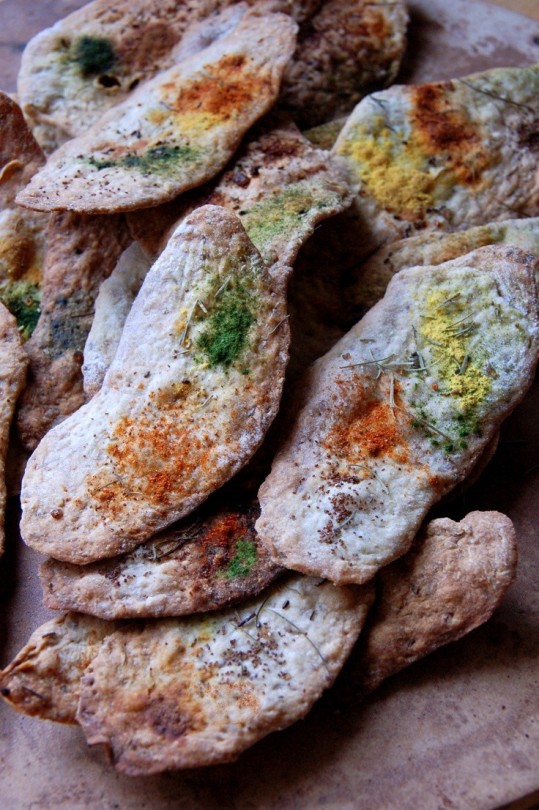

Description from wild food instructor and traditional food preservation technique researcher Pascal Baudar via Pinterest:
Wild flour and seeds crackers. Curly Dock flour, Nettles flour, Californian buckwheat, some regular wheat flour on top, white sage seeds, plantain seeds, lambquarters flour, cattail pollen, and Californian sagebrush. (urbanoutdoorskills.com)
#vegan#snacks#crackers#wild foods#stinging nettles#curly dock#lambsquarters#plantain (Plantago spp.)#buckwheat#sage#mustard seeds#yucca root#cattail#fennel pollen#not a recipe#if you do decide on making any of today's recipes be sure you forage/source sustainably or not at all#Also be 150% sure in your identifications 💕
14 notes
·
View notes
Text
The knowledge of some common plants
Since many people don't know most of the plants around them, this is information on some plants that are commonly seen in many places throughout the world

This is Lamium purpureum, also called Purple Deadnettle.
It's called deadnettle because it looks like a nettle but it doesn't sting you
This plant is a winter annual—it grows its leaves in the fall, lasts through the winter, and blooms and dies in the spring
Its pollen is reddish orange. If you see bees with their heads stained reddish orange, it is likely because they have visited Purple Deadnettle
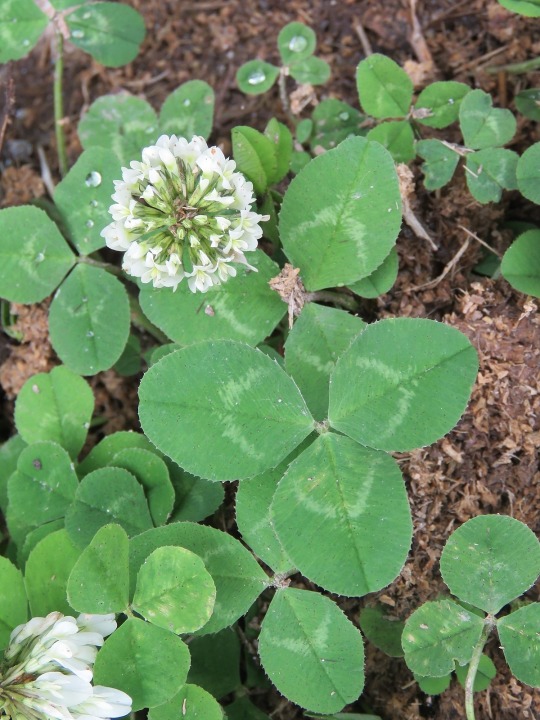
This is Trifolium repens, white clover
It is a legume (belongs to the bean family) and fixes nitrogen using symbiosis with bacteria that live in little nodules on its roots, fertilizing the soil
It is a good companion plant for the other members of a lawn or garden since it is tough, adaptable, and improves soil quality. According to my professor it used to be in lawn mixes, until chemical companies wanted to sell a new herbicide that would kill broadleaved plants and spare grass, and it was slandered as a weed :(
It is native only to Europe and Central Asia, but in the lawns they are doing more good than harm most places
Honeybees love to visit clover
Four-leaf clovers are said to be lucky
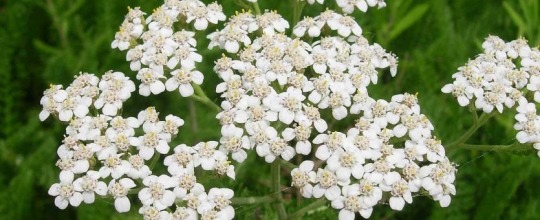
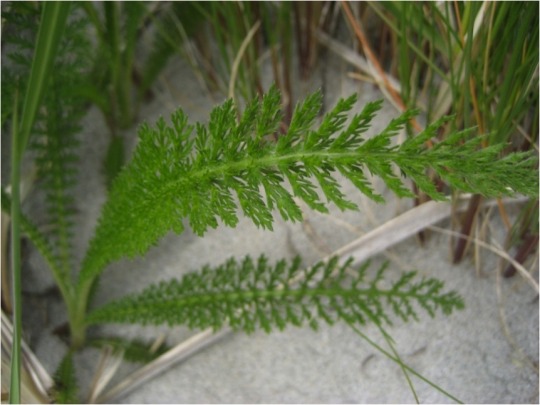
This is Achillea millefolium, Common Yarrow
It has had a relationship with humans since Neanderthals were around, at least 60,000 years, since Neanderthals have been found buried with Yarrow
Its leaves have been used to stop bleeding throughout history, and its scientific name comes from how Achilles was said to have used Yarrow to stop the blood from the wounds of his soldiers. A leaf rolled into a ball has been used to stop nosebleeds
It is a native species all throughout Eurasia and North America

This is Cichorium intybus, known as Chicory
The leaves look a lot like dandelion leaves, until in mid-spring when it begins growing a woody green stem straight up into the air
Like many other weeds, it has a symbiotic relationship with humans, existing in a mix of domesticated or partially domesticated and wild populations
It is native to Eurasia, but widespread in North America on roadsides and disturbed places, where it descended from cultivated plants
Its root contains large amounts of inulin, which is used as a sweetener and fiber supplement (if you look at the ingredients on the granola bars that have extra fiber, they usually are partly made of chicory root) and has also been used as a coffee substitute
A large variety of bees like to feed upon it

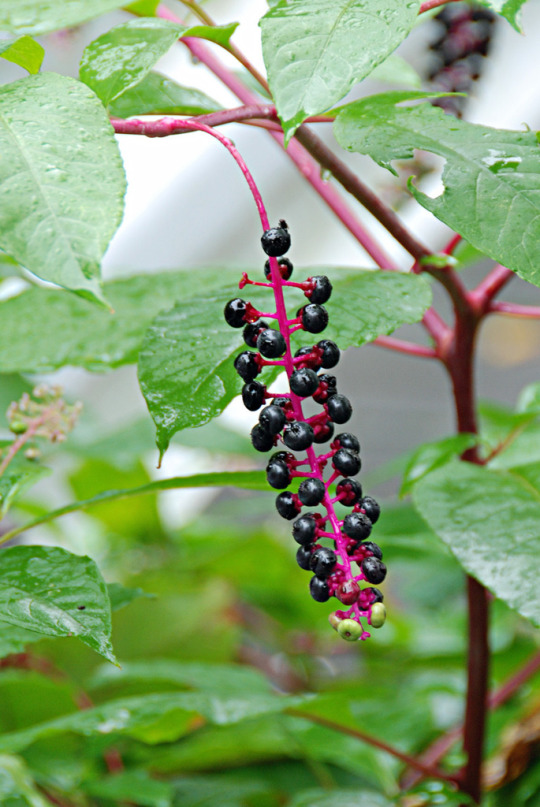
This is Phytolacca americana, known as Pokeweed
It is easily identified by its huge leaves and its waxy, bright magenta stem
It can grow more than nine feet tall from a sprout in a single summer!
If you squish the berries, the juice inside is a shocking magenta that is so bright it almost burns your eyes. For this reason many Native American people used it for pink and purple dye.
It is a heavy metal hyperaccumulator, particularly good for removing cadmium from the soil
All parts of the plant are poisonous and will make you very sick if you eat them, however if the leaves are picked when very young and boiled 3 times, changing out the water each time, they can be eaten, and this is a traditional food in the rural American Southeast, but I don't want to chance it
British people have introduced it as a pretty, exotic ornamental plant. I think that is very funny considering that here it is a weed associated with places where poor people live, but maybe they're right and I need to look closer to see the beauty.
If you see magenta stains in bird poop it is because they ate pokeweed berries- birds can safely eat the berries whereas humans cannot

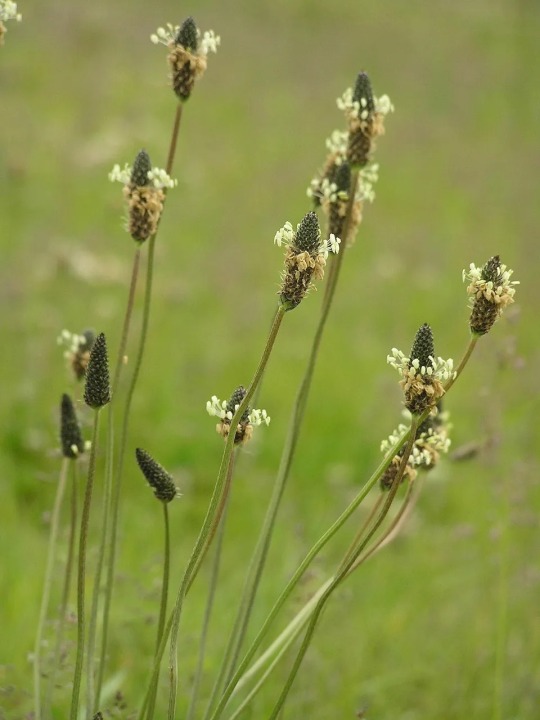
This is Plantago lanceolata, Ribwort Plantain
It grows in heavily disturbed soils, in fact it is considered an indicator of agricultural activity. It is successful in the poorest, heaviest and most compacted soil.
The leaves, seeds, and flower heads are said to be edible but the leaves are really stringy unless they are very young. Of course, it is important to be careful when eating wild plants, and make sure you have identified the plant correctly and the soil is not contaminated
I have also heard the strings in the leaves can be extracted and used for textile purposes
and that's some common plants you might often see throughout the world
#just remembered i had this in my drafts#i forget why i didn't post it immediately#anyway#plants#the ways of the plants
4K notes
·
View notes
Text
dear hank and john, you know how you can get both psyllium and lion's mane mushrooms? foraging!
#I do feel ridiculous buying metamucil when i could process roughly infinite plantago seeds#but i use it as an extender in season#lion's mane is harder to find in quantity#foraging is my quarantine coping mechanism
1 note
·
View note
Text
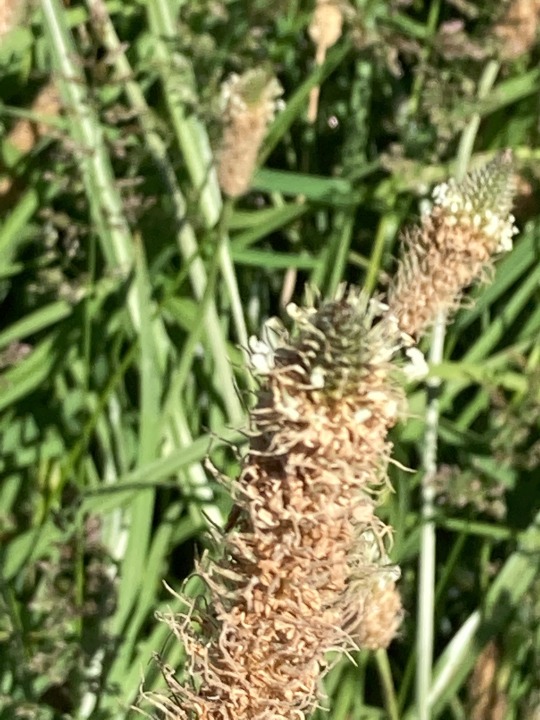


#ribwort plantain#plantains#plantago lanceolata#microflora#grass seed heads#flowering grasses#aquatic plants#lake merritt#oakland
0 notes
Text
hey do yall want a fun plant fact??
This plant, right? Greater Plantain, scientific name Plantago major?

It's known as "white man's footprint", and the reason is so cool 2 me (Taken from the Wikipedia page for Plantago major):
The plant is native to most of Europe and northern and central Asia,[9][8][2] but has widely naturalised elsewhere in the world.[9][10][11][12][13]
Plantago major grows in lawns and fields, along roadsides, and in other areas that have been disturbed by humans. It does particularly well in compacted or disturbed soils. It is believed to be one of the first plants to reach North America after European colonisation. Reportedly brought to the Americas by Puritan colonizers, plantain was known among some Native American peoples by the common name "white man's footprint", because it thrived in the disturbed and damaged ecosystems surrounding European settlements.[14] The ability of plantain to survive frequent trampling and colonize compacted soils makes it important for soil rehabilitation. Its roots break up hardpan surfaces, while simultaneously holding together the soil to prevent erosion.[15]
The seeds of plantain are a common contaminant in cereal grain and other crop seeds. As a result, it now has a worldwide distribution.[10]
anyways download iNaturalist and the Seek app if yall like this kind of stuff i am having the time of my life identifying random plants!! i <3 collecting weird little facts about nature it's so fascinating!!
#i love ecology.... foaming at the mouth at how cool it is to just be able to learn about these things on the interwebs#holy shit#inaturalist#biodiversity#invasive species#environment#citizen science
87 notes
·
View notes
Text
Things I Use Up/Wear Out:
Food — couponing, foraging, gardening, Buy Nothing, dumpster diving
Toiletries — couponing, dumpster diving
conditioner, shampoo, soap/body wash
toothpaste, floss — also dentist freebies
kid's size toothbrushes. much harder to get than adult sizes but apparently my mouth spacing is better served by the little ones
skin relief
menstrual products
nail polish
deodorant (the hardest!)
Household — couponing, dumpster diving
laundry detergent
dish soap
tissues, paper towels, toilet paper
parchment paper, aluminum foil
sponges! exciting when they show up
Clothes
socks — gifts, freebies [hopefully repairs!]
hiking boots, sneakers — thrifting, dumpster diving, repairs
casual/lounge pants — thrifting, dumpster diving, repairs
Health — couponing but sometimes even spending $ oh no
Metamucil (+ foraged plantago seeds)
vitamins
painkillers
Notebooks/pads of paper — dumpster diving, freebies
6 notes
·
View notes
Text
Macbeth
- Well, the bad news is the list of named plants is supershort:
- chesnuts
- primrose
- corn (not American corn, but old world grains (I think))
- rhubarb
- senna
Chestnuts would be a decent tree option, a cheap too if you can grow from either chestnuts (seeds) or hardwood cuttings. Primroses are a nice springtime flower, and could bring some yellow/white color. Corn/grains are also dead-easy to grow from seeds. Rhubarb is sold as bareroot plants in late winter/early spring in my area in superstores, and would be producing a crop in a few years if I’ve understood what I’ve seen on Gardener’s World about them. Senna is mentioned alongside rhubarb as a laxative/curative by Macbeth; I would advise holding off on growing it until you’ve done extensive research, both on how it might grow in your climate and if it might interact via contact with any of your medications.
As you can see, the pickings are pretty paltry BUT, the good news is that some scholars think that the famous witches’ spell (double bubble, and all that) contains several folk names for plants and herbal medicines. Using this site I’ve come up with some plants that would be suitable for a casual gardener’s Witches Brew Garden:
-Toad entrails = Toadflax, Linaria vulgaris
- Fillet of a fenny snake = Yarrow, Achillea millefolium; Bistort/Snakeroot, Bistorta officinalis; Plantains/Fleaworts, Plantago genus (lots of common weeds fall under these names)
- Eye of newt = mustard seeds
- Toe of frog = Bulbous buttercup, Ranunculus bulbosus
- Wool of bat = holly leaves
- Tongue of dog = Houndstounge, Cynoglossum officinale
- Adder’s fork = Dog’s tooth violet, Erythronium
- Blind-worm’s sting = Poppies, Papaver somniferum
- Lizard’s leg = Ivy (choose one that that is not listed as invasive in your area)
- Scale of dragon = Tarragon, Artemisia dracunculus (or Tagetes lucida if you want to grow from seed)
- Liver of blaspheming Jew (yikes) = Mugwort, Artemisia vulgaris
- Gall of Goat = Honeysuckle, Lonicera sempervirens (or your areas natural honeysuckle species; definitely do not plant amur honeysuckle); St. John’s Wort, Hypericum perforatum
- Slips of yew = Yew, Taxus baccata (or local species)
- Finger of birth-strangled babe = Cinqefoil, Potentilla genus
- Tiger’s Chaudron = Lady’s mantle, Alchemilla mollis
- Owlet’s wing = garlic or ginger
Personally, I have two plastic cauldrons that I am planning to use for some Macbeth gardens.
#shakespeare#Shakespeare Garden#macbeth#fair warning that the witches brew plants are not my own research#i DID try to find some sourcebooks instead of relying on this website but I Don't Have that Kind of Money
4 notes
·
View notes
Text
One of the finest bases for a salad is young heart-shaped leaves from the lime tree, the very best being from the small-leaved lime (Tilia cordata), which are hairless. These should be shiny and lime green in colour. They taste just like lettuce – surprisingly so – but I think they hold salad dressing better and don’t wilt so fast. They are exceptionally good in sandwiches.
I also like the very youngest leaves of hawthorn ( Crataegus monogyna); again, they need to be a vibrant, new green and just a few centimetres long. The leaves are alternate, as opposed to opposite, so borne along the stem in an alternate spiral, with five to seven lobes and teeth on the tips. Hawthorn leaves are said to protect the heart both emotionally and physically, and are known to be good for circulation. They taste fresh and grassy green and their pretty serrated edges make them attractive for salads.
I cannot get enough of dandelions (Taraxacum officinalis) at this time of year. Every part is edible and packed full of good stuff: they are rich in potassium, for instance. They are bitter, like an endive, but sometimes more so, thus you need to go for the very youngest inner leaves, again lime-green, indicating new growth. If the bitterness is too much, soak them in salted water for 10 minutes or so. In salads, I am also mad about the flower stems, which taste a bit like Italian chicory (puntarelle) and can be treated exactly the same way. You only want the new stems of flower buds or flowers; by the time the plant is setting seed the stem will be full of chewy fibres. I chop the stems diagonally into segments, salt them well and then dress them in oil and little else. They are very good with chopped boiled eggs and a little finely diced red onion.
Chickweed (Stellaria media) is another excellent base, with a flavour not too dissimilar to that of corn salad. It may well be in flower now, but if it is growing somewhere damp enough, will still be tender. It is low-growing and mat-forming, with delicate little egg-shaped leaves and tiny white flowers.
The wild garlic (Allium ursinum) season is almost over, but in cooler spots you may find unripe seed to pick. These will appear on the ends of the seedheads and are ball-shaped, in clusters of three. They should be bright green in colour, rather than yellow. They give an intensely sweet garlic burst and are particularly good turned into salt (mix equal parts coarse sea salt and seeds), which will preserve into winter. This is very good in salad dressings.
Lemon balm (Melissa officinalis), fennel (Foeniculum vulgare) and perennial wall rocket (Diplotaxis tenuifolia) are garden escapees that are often found in abundance in cities and towns along paths and walls and are excellent for bulking out a salad.
Sheep’s sorrel (Rumex acetosella) is another good one, though you want it growing somewhere damp so that it is succulent. In dry spots, it gets very tough. It has oblong, arrow-shaped leaves and tall spikes of pink flowers. If it has flowered (which is likely right now) and gone to seed, steal these if they are still bright pink and fleshy. Scattered through a salad, they give a pleasing burst of lemon.
The unopened flowers of narrow-leaved or ribwort plantain (Plantago lanceolata) can be briefly steamed until tender, allowed to cool and dressed with a vinaigrette and tossed into a mixed salad or treated a little like asparagus, although they taste surprisingly like mushrooms. The leaves are long, narrowly oval with veins running parallel from the base to the top. The flower spikes are square and the unopened flowers are pine cone-shaped.
Likewise, the unopened flowers of oxeye daisy (Leucanthemum vulgare), which looks like an oversized lawn daisy and grows to 60cm high, can be briefly steamed and marinated, or pickled like capers. The white petals are lovely scattered in for some colour. The leaves are also edible, although they are quite bitter and perfumed by the time the plant flowers. If you can find them before then, they are much more desirable.
A better option are the leaves of the common or lawn daisy (Bellis perennis), which can be used raw, where they have an interesting fleshy texture, or cooked, which is my preferred method. The leaves are paddle-shaped and slightly hairy. Once cooked, they soak up dressing in a very pleasing manner. The flowers can be eaten too – they don’t taste of much, but look pretty.
Finally, there are excellent vinegars to be made from creamy white umbels of common elder (Sambucus nigra), the long, tubular yellow flowers of common honeysuckle (Lonicera periclymenum) and palest pink petals of dog rose (Rosa canina). All can be found in hedgerows right now. The adventurous can make these vinegars from scratch, by fermenting the flowers in sugar and water, but that takes time, so for a quicker solution use good-quality white wine vinegar or raw cider vinegar and infuse just the flowers (never the stems) for several days for a deliciously perfumed dressing.
Some of these are may be fairly region specific, but several also happen to be invasive in a lot of places, making them great foraging options. The link contains some helpful dos and don'ts, and suggestions for further reading, so if you are interested but new to foraging, I recommend clicking through.
#foraging#food#salads#food security#plants#personally I can't stand the taste if dandelions but there are so many hawthorns here and now I'm keen to try that
9 notes
·
View notes
Photo

Herbal Medicine Recipes for Kidney Stone with Diabetes
For patients with kidney stones disease who are accompanied by diabetes, the recipe used is not only to cure kidney stone but also added medicinal plants to treat diabetes.
Recipe I added mimba (Azadirachta indica) leaves, commonly known as neem, nimtree or Indian lilac.
Also added brotowali (Tinospora cordifolia).
Recipe II added ciplukan(Physalis angulata) and jamblang seeds (Syzygium cumini), commonly known as Malabar plum, Java plum, black plum, jamun or jambolan.
Recipe III added lidah buaya (Aloe vera) and tapak dara (Catharanthus roseus) also known as bright eyes, Cape periwinkle, graveyard plant, Madagascar periwinkle, old maid, pink periwinkle, or rose periwinkle.
What are the recommendations during the healing period of kidney stone disease accompanied by diabetes using herbal medicine?
Control stress
Drink at least two liters of water a day
Avoid sweet, sugary, and high-carbohydrate foods
Drink the juice of long beans, bitter melon, cucumber, garlic, or aloe vera
Light exercise routine every morning
Recipe I
Ingredients:
5 g dry or 20 g fresh mimba (Azadirachta indica) leaves
10 g dry brotowali (Tinospora cordifolia)
10 g dry or 30 g fresh sambiloto plant (Andrographis paniculata)
10 g dry or 30 g fresh keji beling leaves (Strobilanthes crispa)
5 g dry or 20 g fresh meniran plant (Phyllanthus urinaria)
How to make:
Wash all the ingredients, then poach in one liter of water until the remaining half.
Remove, strain.
How to consume:
Drink three times a day.
In the morning, afternoon, and evening.
Once drink as much as 150 ml.
Recipe II
Ingredients:
10 g dry or 30 g fresh ciplukan plant (Physalis angulata)
10 g dried jamblang seeds (Syzygium cumini)
10 g dry or 30 g fresh sambiloto (Andrographis paniculata)
10 g dry or 30 g fresh cat whiskers (Orthosiphon aristatus)
10 g dry or 30 g fresh tapak liman (Elephantopus scaber)
How to make:
Wash all the ingredients, then poach in one liter of water until the remaining half.
Remove, strain.
How to consume:
Drink three times a day.
In the morning, afternoon, and evening.
Once drink as much as 150 ml.
Recipe III
Ingredients:
30 g fresh tapak dara leaves (Catharanthus roseus)
10 g dry or 30 g fresh daun sendok (Plantago major)
70 g of fresh aloe vera leaf flesh
10 g dry or 30 g fresh sambiloto plant (Andrographis paniculata)
10 g dry or 30 g fresh putri malu (Mimosa pudica)
10 g dry or 30 g fresh tempuyung (Sonchus arvensis)
How to make:
Wash all the ingredients, then poach in one liter of water until the remaining half.
Remove, strain.
How to consume:
Drink three times a day.
In the morning, afternoon, and evening.
Once drink as much as 150 ml.
https://english.tajba.com/herbal-medicine-recipes-for-kidney-stone-with-diabetes/
4 notes
·
View notes
Text

On the rooftop. They share sweets 🍭
#Blue River#Plantago Seed#Xu Boyuan#qzgs#the king’s avatar#quan zhi gao shou#watercolor#haven't posted them here yet
8 notes
·
View notes
Text
PureHusk: The Best Selling Ispaghol Husk in Pakistan
Introduction:
Ispaghol husk, derived from the seeds of Plantago ovata, has long been recognized for its numerous health benefits, particularly in aiding digestion and promoting overall gut health. In Pakistan, where traditional remedies often hold sway, Ispaghol husk has been a staple in many households for generations. Among the plethora of brands offering this natural remedy, PureHusk stands out as the best-selling choice for discerning consumers across the country.
What Sets PureHusk Apart?
1. Quality Assurance:
- PureHusk prides itself on maintaining the highest standards of quality throughout the production process. From sourcing premium-grade Ispaghol seeds to employing stringent quality control measures during manufacturing, every step is carefully monitored to ensure purity and efficacy.
2. Trusted Reputation:
- With years of experience in the market, PureHusk has earned the trust and loyalty of countless customers. Its reputation for reliability and consistency has solidified its position as the go-to brand for Ispaghol husk among health-conscious individuals and healthcare professionals alike.
3. Effective Digestive Aid:
- PureHusk's Ispaghol husk is renowned for its effectiveness in promoting digestive health. Its natural fiber content helps regulate bowel movements, alleviate constipation, and support a healthy digestive system. Consumers attest to the noticeable difference in digestive comfort and regularity when incorporating PureHusk into their daily routine.
4. Versatility and Convenience:
- PureHusk offers a range of convenient packaging options to suit varying preferences and lifestyles. Whether in powder form for easy mixing into beverages or capsules for on-the-go consumption, PureHusk ensures accessibility without compromising on quality.
5. Commitment to Customer Satisfaction:
- Beyond delivering a superior product, PureHusk places a strong emphasis on customer satisfaction. Responsive customer service, informative resources, and transparent communication contribute to a positive overall experience for consumers.
The PureHusk Experience:
- Incorporating PureHusk into your daily wellness regimen is not just about consumption; it's about embracing a lifestyle centered around holistic health. By choosing PureHusk, consumers are not only investing in a premium product but also prioritizing their well-being with a brand they can trust.
Conclusion:
In a market flooded with options, PureHusk stands tall as the best-selling Ispaghol husk in Pakistan for a reason. Its unwavering commitment to quality, backed by a legacy of trust and effectiveness, has made it the preferred choice of discerning consumers seeking natural solutions for digestive wellness. With PureHusk, you're not just buying a product – you're investing in your health and embracing a tradition of excellence that has endured for generations.
0 notes
Text
From Bland to Brilliant: Fun Ways to Make Psyllium Husk a Part of Your Routine
Nutritionists, doctors, and dietitians worldwide emphasize the significance of incorporating fiber into one's diet to enhance digestion, promote gut health, and facilitate weight management. Fiber plays a crucial role in overall health improvement and maintenance. Psyllium husk, a fiber-rich plant product, has emerged as a revolutionary addition to the health industry, offering numerous benefits. Psyllium Husk is obtained from the seeds of the plant called plantago Plantago ovata. Since it is 100% plant products, it is 100% vegan, and versatile dietary fiber. It is well known across the globe immense health benefits, including improved digestion, weight management, and heart health.

One should include following tips and tricks to incorporate psyllium husk in daily diet or daily intake.
Slow Start : At the initial stage of staring intake of psyllium , one should be careful with amount of psyllium husk to be consumed. This amount depends upon the age, body health and current medical condition. Starting with small quantities of psyllium husk will help your body to adapt the change in the fiber content of the food consumed. May be one can start with consuming half a teaspoon along with a glass of water or your favourite drinks.
Hydration: Psyllium husk a beautiful property of absorbing water to great extent and there by forming a gel like substance. This helps soften stool and regulate bowel movements. If fluids are not taken in appropriate amount it may create hard gel resulting in stomach and intestine discomfort. When consuming psyllium husk, one should aim to drink for at least 8 glasses of water per day to keep yourself hydrated.
Mixing and Recipes: Psyllium husk tastes bland so best way to consume it is with flavoured beverages juices, lemonade smoothies, buttermilk, shakes oatmeal etc. Psyllium husk can also be used in baking cakes, bread, cookies, buns, which can be easily consumed as daily meals. One should experiment with different recipes and find what works best for oneself.
Timing Of Consumption: Dietician and nutritionist advice that to have maximum benefits of psyllium husk, please have it before 30 minutes of you mealtime. This will create a signal to to your brain that your stomach is full which in turn will reduce the overeating pattern and help in weight management.
Listen to Your Body: Looking into the benefits of having psyllium in out diet, one should pay attention to one’s body and how it reacts to psyllium husk. Normally, I can be called a safe threshold to consume 1 tablespoon of husk for direct consumption. Sometimes, someone may experience bloating, gas, or other digestive issues. Hence it it is advised to have psyllium husk with consultation of doctors or experts.
Quality and Storage: While considering psyllium husk one should keep the quality and brand in mind before purchasing. Psyllium husk being a plant based product should be free from dust, insects and microbial parameters. About storage one should store ths product in airtight container to avoid contact with moisture in the atmosphere. A cool and dry place is best to maintain its freshness and potency.
Adding psyllium husk to our daily intake can be made simple and effective way to improve overall health. One should keep in mind important aspect of quality, hydration and being mindful about consumption.
When is comes to quality of psyllium husk and buying good pure husk, it is recommended to buy from best psyllium husk manufacturer and exporter from India named Veeral Agro Tech and Kisan Agro. If you want to buy good quality psyllium husk please contact [email protected] where you will get genuine responses for psyllium husk.
#Psyllium fiber benefits#Psyllium husk recipes#Psyllium husk for weight loss#Psyllium husk smoothie#Psyllium husk health benefits#Psyllium husk for gut health
0 notes
Text
Psyllium Husk : Does Psyllium Husk Really Help You Lose Weight?

Psyllium husk is a type of soluble fiber derived from the seeds of the Plantago ovata plant. It's commonly used as a dietary supplement due to its potential health benefits, including aiding in weight loss. Here, you can choose the right brands psyllium husk weight loss in short time.
Here's how psyllium husk can help with weight loss:
1.Increased satiety: Psyllium husk has a high water-holding capacity, so it absorbs water and forms a gel-like substance in the digestive tract. When mixed with water, this gel expands in the stomach, creating a sense of fullness or satiety. As a result, you may eat less, resulting in lower calorie intake and possible weight loss.
2.Regulation of appetite: By increasing feelings of fullness, psyllium husk may help regulate appetite and reduce cravings for unhealthy foods or excessive snacking, which can aid in weight loss by encouraging better food choices and portion control.
3.Improved digestion: Psyllium husk is well known for its ability to regulate bowel movements and relieve constipation. Regular bowel movements help to prevent bloating and promote a healthy digestive system, both of which can help with weight management.
4.Reduced absorption of calories: Soluble fibers, such as psyllium husk, can bind to fats and sugars in the digestive tract, slowing their absorption into the bloodstream. This may help prevent blood sugar spikes and reduce calorie absorption from food, potentially helping with weight loss efforts.
5.Balanced gut microbiota: Psyllium husk serves as a prebiotic, feeding beneficial bacteria in the gut. A balanced gut microbiota has been linked to improved weight management and metabolic health.
6.Lower cholesterol levels: Some studies suggest that psyllium husk may help lower LDL cholesterol levels, which is beneficial to heart health. While not directly related to weight loss, having a healthy cholesterol level is critical for overall health.
Some studies suggest that psyllium husk may help lower LDL cholesterol levels, which is beneficial to heart health. While not directly related to weight loss, having a healthy cholesterol level is critical for overall health. Furthermore, drinking plenty of water while consuming psyllium husk is essential to avoid potential digestive issues. Before incorporating psyllium husk into your daily routine, consult with a healthcare professional, especially if you have any underlying health conditions or are taking medication. Here, you can choose the other weight loss products from the list of weight loss products in India at affordable price.
0 notes
Text
Unblock Your Comfort: Embrace Natural Constipation Relief

In a world filled with fast-paced living and processed foods, it's not uncommon to encounter digestive discomforts like constipation. While there are numerous remedies available, both natural and pharmaceutical, sometimes the best solutions lie in the wisdom of traditional practices. Enter Sandook, a humble yet potent remedy derived from nature, offering gentle relief from constipation and promoting overall digestive health.
Understanding Constipation: A Common Woe
Constipation, characterized by infrequent bowel movements or difficulty passing stools, can wreak havoc on one's daily routine and overall well-being. Factors such as poor dietary choices, inadequate hydration, lack of physical activity, and stress often contribute to this uncomfortable condition. While over-the-counter medications may provide temporary relief, they often come with unwanted side effects and may not address the root cause of the problem.
The Hidden Gem: Sandook
Sandook, also known as Psyllium Husk, is a natural fiber derived from the seeds of the Plantago ovata plant. For centuries, it has been revered in traditional medicine systems like Ayurveda for its remarkable digestive benefits. Here's why Sandook is considered a powerhouse remedy for constipation:
High Fiber Content: Sandook is packed with soluble fiber, which absorbs water and forms a gel-like substance in the intestines. This helps soften stools, making them easier to pass.
Promotes Regularity: By adding bulk to the stool, Sandook stimulates bowel movements and promotes regularity without causing harsh or abrupt changes to the digestive system.
Gentle on the Stomach: Unlike some laxatives that can irritate the stomach lining, Sandook is gentle and well-tolerated by most individuals, making it suitable for long-term use.
Supports Gut Health: Along with relieving constipation, Sandook also supports overall gut health by nourishing beneficial gut bacteria and promoting a healthy microbiome.
Incorporating Sandook into Your Routine
Adding Sandook to your daily routine is simple and hassle-free. Here are a few easy ways to incorporate this natural remedy into your diet:
Mix with Water: Simply mix one to two teaspoons of Sandook with a glass of water and drink it immediately. Follow it up with another glass of water to ensure adequate hydration.
Blend into Smoothies: Add a spoonful of Sandook to your favorite smoothie or juice for an extra boost of fiber without altering the taste.
Bake into Recipes: Get creative in the kitchen by incorporating Sandook into baked goods like muffins, bread, or cookies for a fiber-rich treat.
Embrace Natural Relief with Sandook
In a world inundated with synthetic medications and quick fixes, Sandook stands out as a beacon of natural relief for constipation. Its gentle yet effective action not only provides immediate relief but also supports long-term digestive health. So, the next time you find yourself grappling with digestive discomfort, consider turning to this time-tested remedy derived straight from Mother Nature herself. Your gut will thank you for it!
Disclaimer: While Sandook is generally safe for most individuals, it's always advisable to consult with a healthcare professional, especially if you have pre-existing medical conditions or are taking medications.
0 notes